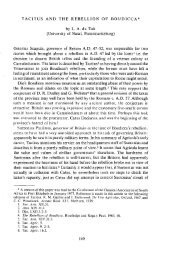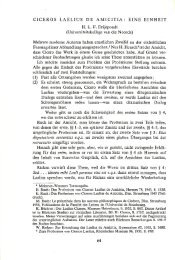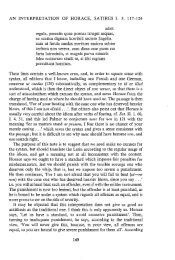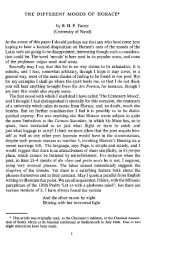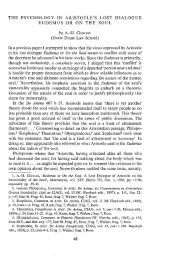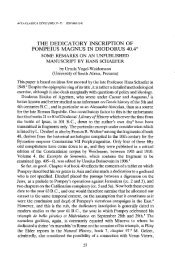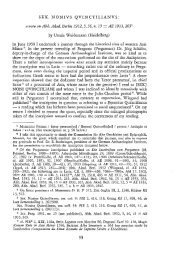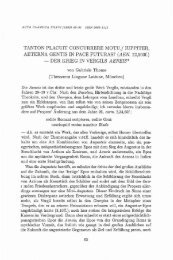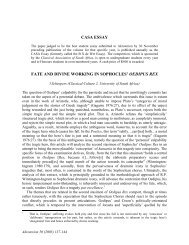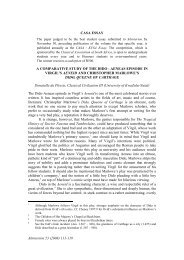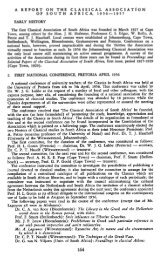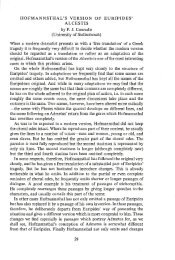LINGUISTIC THEORY AND THE GREEK CASE SYSTEM by JP Louw
LINGUISTIC THEORY AND THE GREEK CASE SYSTEM by JP Louw
LINGUISTIC THEORY AND THE GREEK CASE SYSTEM by JP Louw
Create successful ePaper yourself
Turn your PDF publications into a flip-book with our unique Google optimized e-Paper software.
<strong>LINGUISTIC</strong> <strong><strong>THE</strong>ORY</strong> <strong>AND</strong> <strong>THE</strong> <strong>GREEK</strong> <strong>CASE</strong> <strong>SYSTEM</strong><br />
<strong>by</strong> J.P. <strong>Louw</strong><br />
(University of the Orange Free State, Bloemfontein)<br />
There is a vast literature on the cases in Indo-European languagesespecially<br />
the Classical languages. These cases are traditionally treated<br />
more or less as individual entities, as items on a list: one case after the<br />
other is discussed and with each a number of its usages is mentioned, so<br />
that it has become customary to speak of different kinds of accusatives,<br />
datives, etc. In this respect the genitive is favoured with no less than 30<br />
kinds: possessive genitive, genitive of quality, partitive genitive, etc. 1<br />
Practically speaking there is sense in this procedure as long as one remembers<br />
that these names are merely appellations to distinguish the different<br />
contextual variations of usage, and that they do not serve to explain the<br />
case itself. I prefer to call this method of approach grammatical. 2<br />
This method of describing the various usages has, however, mutatis<br />
mutandis, been employed to explain the case system itself. Consequently<br />
the idea emerged that at least one of these usages must deri.ote the original<br />
function of the case. Grammar books often contradict one another as to<br />
the original function of a case. 3 Besides, the question is often put: is it<br />
possible to discover a single principle, or even meaning, underlying the<br />
various usages of each case ? 4 ·<br />
Under the influence, no doubt, of the idea of progressive evolution, it<br />
has been supposed that the cases denoted, in the first instance, relations of<br />
space, and were afterwards gradually extended to the expression of more<br />
intellectual and. abstract relations. This so-called 'local theory' 5 has been<br />
proved inadequate to explain all the cases and their different usages. The<br />
inexplicable residue-one may almost say-was then included under the<br />
name grammatical. 6 Cases were then not only divided into local and<br />
grammatical cases, 7 but at least one case, the accusative, was assigned both<br />
1. Cf. inter alia A. W. de Groot: 'Classification of the uses of a case illustrated on the<br />
genitive in Latin',Lingua VI, 1957, pp. 8-66 (especiallypp. 10-12).<br />
2. Employing the term in the 'descriptive' sense as suggested <strong>by</strong> F. de Saussure: Cours<br />
de Linguistique Generate, Paris 1915, 1960, p. 185.<br />
3. Compare, for example, the definitions given <strong>by</strong> H. W. Smyth: Greek grammar, rev.<br />
<strong>by</strong> G. M. Messing, Cambridge, Mass., 1956; J. Humbert: Syntaxe Grecque, Paris 1960;<br />
and E. Schwyzer-A. Debrunner: Griechische Grammatik, Mtinchen 1959, Vol. II.<br />
4. Cf. E. Schwyzer-A. Debrunner, p. 67.<br />
5. H. H. Htibschmann: Zur Kasuslehre, Mtinchen 1875, p. 49.<br />
6. R. Ktihner-B. Gerth: Ausfohrliche Grammatik der Griechisclze Sprache, Vol. II\<br />
Leipzig 1898, p. 290 ff.; H. Hirt: Indogermanische Grammatik, Vol. VI, Heidelberg 1934,<br />
p. 37.<br />
7. The locative, instrumental and ablative were regarded as local cases, the nominative,<br />
genitive and dative as grammatical.<br />
73
local and grammatical uses. 8 Where this method failed to explain all the<br />
examples, categories like free uses, occasional uses or exceptional uses were<br />
added. 9 This reminds one of the aphorism wrongly applied, and fatally<br />
nursed, <strong>by</strong> some grammarians: the exception proves the rule.<br />
As matters stand today, classical philologists usually content themselves<br />
with saying that a particular dative, for example, is a 'dative of respect',<br />
and when, a paragraph or two further on, we find an 'accusative of respect',<br />
we describe it as such-without questioning our conception of the particular<br />
usage of the case. Smyth 10 comments in this connection that they are<br />
nearly equivalent, but we seek in vain for any allusion to the meaning of<br />
these terms. Many other grammars-even the monumental Griechische<br />
Grammatik <strong>by</strong> Schwyzer and Debrunner-never investigate these rival<br />
constructions.U<br />
To note the implications of the foregoing statements, one need go no<br />
further than K. Brugmann's Griechische Grammatik, 1913, in which he<br />
denies the possibility of arriving at a 'Grundbedeutung der Kasusformen',<br />
but prefers the term 'Gebrauchsurnfang' 12 as being the oldest denotation(s)<br />
of a case we can possibly arrive at. Although many grammarians have<br />
endeavoured to establish a definition of the 'Gebrauchsurnfang' of a case,<br />
the crux of the problem has always been to correlate it with the various<br />
usages-undoubtedly because diachronic material was employed to account<br />
for synchronic facts. The result of this method was a grouping of the<br />
usages of a case, not an explanation of its meaning. Consequently it is at<br />
least comprehensible that, although Schw)rzer and Debrunner take the<br />
idea of 'Gebrauchsurnfang' into consideration, they conclude that it is<br />
impossible to find any system in the uses of, for example, the accusativeP<br />
The eminent French scholars Chantraine and Meillet-Vendryes maintain<br />
that the accusative is on the whole the case of the object. 14 'On the whole'<br />
. 8. H. J. Jacobsohn in Festschrift Wackernagel, Gottingen 1923, p. 207; J. B. Hofman:<br />
Lateinische Syntax und Stilistik, bearb. v. A. Szantyr, Miinchen 1963, p. 30; H. Hirt:<br />
op. cit., p. 37; E. C. Woodcock: A New Latin Syntax, London 1959, p. 1.<br />
9. Cf. H . W. Smyth: op. cit., par. 1388, 1600; R. Kiihner-B. Gerth: op. cit., par. 412;<br />
J. Humbert: op. cit., par. 439; E. Schwyzer-A Debrunner: op. cit., p. 84, 128.<br />
10. Op. cit., par. 1388, 1600.<br />
11. Although basic works such as Schwyzer-Debrunner as well as Szantyr's recently<br />
revised edition of Leumarm-Hofmann: Lateinische Grammatik quote, e.g., in their<br />
bibliographical sections modern linguistic analyses like Hjelmslev's La categorie des cas<br />
(1935-37), no attention in their treatment of the cases is given to these far-reaching<br />
modern approaches. No wonder that L. H. Gray (Foundations of Language, p. 460) as far<br />
back as 1939 lamented the fact that the average Classicist is relatively unsympathetic to,<br />
and unaffected <strong>by</strong>, linguistics.<br />
12. K. Brugmann: Griechische Grammatik, Miinchen 1913, par. 436.<br />
13. op. cit., Vol. II, pp. 56, 67.<br />
14. P. Chantraine: Grammaire Homerique, Paris 1953, Vol. II, p. 38. A. Meillet-<br />
J. Vendryes: Traite de Grammaire Comparee des Langues C!assiques, Paris 1960, par. 816.<br />
74
shows that they resort to the most obvious usage as a starting-point, and<br />
that they intend to give a description, not a definition. Humbert says that<br />
it is impossible to find a definition for the accusative which will account<br />
for all its uses. He nevertheless continues: 'II rend sans specification<br />
particuliere la relation de verb a nom'. 15 But this statement is in itself an<br />
effort-and a positive one-to define the accusative in terms of the semantic<br />
value. Humbert is here in line with the modern structural linguistic approach<br />
-a method unfortunately overlooked <strong>by</strong> most Classical scholars, at least<br />
in their persistent adherence to stereotyped formulas. On the other hand<br />
the structural linguistic approach has perhaps often. gone too far in rigorously<br />
denouncing 'traditional grammar',t 6 although many nonsensical<br />
patterns have been exposedP Modern linguistic theories can be successfully<br />
employed (as far as each goes) to solve or to understand many problems<br />
in defining the case system in Greek.<br />
Although modern structuralists have their differences of opinion, they<br />
share two basic conceptions : 18 1. Synchronistic and diachronistic approaches<br />
must be kept neatly apart; 19 2. A case has one fundamental<br />
meaning which may be actualized in different ways. 20<br />
The notion of a fundamental meaning is, within the scope of the structural<br />
approach, not to be confused with the method hinted at <strong>by</strong> Brugmann<br />
and followed <strong>by</strong> Schwyzer- Debrunner, 21 viz. to trace the 'gemeinsame<br />
Gebrauchsumfang' of a case. They understood 'Gebrauchsumfang' as a<br />
more proper term for 'Grundbedeutung' or 'Grund be griff'; that is, they<br />
arrived at the 'original' meaning through the comparative-historical<br />
method based on an analysis of the contextual variations of usage. The<br />
structural method understands <strong>by</strong> 'fundamental meaning' the essential<br />
semantic function of a case which is not the source of its various contextual<br />
15. J. Humbert: op. cit., par. 416.<br />
16. Cf. C. L. Ebeling: 'On Case Theories', Museum 62, 1957, par. 5 referring to L.<br />
Hjelmslev: La Categorie des cas, Etude de grammaire gbzerale, Aarhus 1935-37; A. W. de<br />
Groot: 'Classification of the uses of a case illustrated on the genitive in Latin', Lingua VI,<br />
1956-57, pp. 8-65 and J. Kurylowicz: 'Le probleme du classement des cas', Bulletin de<br />
Ia Societe Polonaise de Linguistique IX, 1949, pp. 2~3. Extreme structuralism which<br />
would regard any historical discipline as unscientific, is justly rejected <strong>by</strong> 0. J. L. Szemerenyi:<br />
Trends and Tasks in Comparative Philology, London 1962.<br />
17. Explicitly <strong>by</strong> their method of separating the non-linguistic moments from the<br />
linguistic, thus exposing 'semantic notions' derived from contextual matters .<br />
18. Cf. C. L. Ebeling, op. cit., p. 130.<br />
19. M. Ivic: '0 problemu pade~ne sisteme u vezi sa savremenim shvatanjima u lingvistickoj<br />
nauci', Juznoslovenski Filolog XX, 1953-54, pp. 191-211 (with a French summary)<br />
rejects this method. We must admit with Ivic that the two approaches cannot be kept<br />
absolutely apart, but they are definitely to be acknowledged. Me iudice a sound basis is<br />
to differentiate without separating.<br />
20. I vic prefers to speak of a bundle of meanings. Cf. L. R. Palmer: The Latin Language,<br />
London 1961, p. 286: 'The accusative exhibits clusters of usage .. .'<br />
21. V. supra, notes 12 and 13.<br />
75
usages, but which comprises its connotation, its potentiality. This method<br />
<strong>by</strong> no means discards or replaces the comparative-historical method<br />
(almost traditional among Classicists), but actually encompasses it,<br />
defining the essence of a case in terms of a principle or a conception within<br />
the range of which the various usages (being contextual applications thereof,<br />
or rather allowing various contextual applications) can be explained,<br />
either in their synchronic occurrence, or in their historical development,<br />
or in their fusion with the usages of other cases. This 'essence of a case'<br />
is not a meaning of the case, but its semantic function in the sentence.<br />
The explanation of the Greek case system among Classical scholars is<br />
traditionally purely contextual (-syntatic) 22 , although the definitions proposed<br />
were usually represented as semantic notions of the case itself. 23 In<br />
reality, however, they were merely contextual common denominators. Thus<br />
we read in Schwyzer-Debrunner 24 that the nominative is the case of the<br />
grammatical subject. This is not at all a semantic definition, but a contextual<br />
one-and as a contextual definition it merely states the most usual contextual<br />
role of the nominative. For the subject is not always nominative, and<br />
the nominative is not always the subject. The same applies to the accusative<br />
when denoting space and time relations or the object; it also applies to the<br />
genitive denoting the partitive relation and that of 'belonging to'; and so<br />
on. 25 It all becomes clear when we read at the end of Schwyzer-Debrunner's<br />
list: ' ... der freie (absolute) Gebrauch einzelner Kasus ist ebenfalls<br />
eine nachtragliche Entwicklung, die nichts tiber die altere konstruktionelle<br />
Anwendung hinaus lehrt' . 26<br />
The structural approach is mainly interested in the semantic values<br />
which it finds <strong>by</strong> separating the linguistic moments from the non-linguistic. 27<br />
The structural method, however, in no way discards, or overlooks, the<br />
syntactic functions. Already in 1939, De Groot wrote: 28 'Les cas peuvent<br />
avoir des fonctions syntaxiques et des fonctions semantiques'. As suggested<br />
<strong>by</strong>the words 'peuvent avoir', the range of the syntactic and the semantic<br />
22. Syntactic in so far as adnominal and adverbal (usually wrongly termed adverbial)<br />
constructions are distinguished.<br />
23. We need not seek better proof than the term 'Gebrauchsumfang'.<br />
24. Op. cit, Vol. II, p. 56 under the heading 'gemeinsame Gebrauchsumfang'.<br />
25. Here lies the reason why we read on p. 89: 'Aber die vielen und verschiedenartigen<br />
Gebrauchsweisen des "echten Genitivs" des Indogermanischen liessen sich wieder nur<br />
durch willktirliche Definitionen auf einen Nenner bringen'.<br />
26. The italics are mine. Is 'konstruktionelle Anwendung' the only matter to be judged<br />
as important in understanding a case??<br />
27. 'To separate lingmstic facts from among a body of data means to detect the form<br />
of expression (the phonemes and their relations) behind the substance of expression (the<br />
speech sounds), and to derive from the substance of content (the things meant) the underlyingform<br />
of content (themeaning).'-C. L. Ebeling: op. cit., p. 130.<br />
28. A. W. de Groot: 'Les oppositions dans les systemes de la syntaxe et des cas',<br />
Melanges de linguistique, offerts a Ch. Bally, Geneve 1939, p. 122.<br />
76
functions is not absolute. De Groot 29 assigns to the nominative, accusative<br />
and genitive only syntactic functions, while the dative and ablative may have<br />
a semantic function. This distinction was suggested as a criticism of the<br />
theories proposed <strong>by</strong> Hjelmslev 30 and Jakobson 31 who gave a semantic<br />
explication of every syntactic use. 32 Kurylowicz 33 agrees with De Groot as<br />
far as the nominative is concerned; for the other cases he assumes both<br />
syntactic and semantic functions, but then one of these is primary, the other<br />
secondary. The accusative and genitive, according to Kurylowicz, may have<br />
a semantic function, although secondary; the dative and ablative have a<br />
primary semantic function, and a secondary syntactic function. We need<br />
not enter upon a criticism of the foregoing theories, for which much can<br />
be said pro and contra, as this has been competently done <strong>by</strong> Ebeling, to<br />
whom the reader is referred.<br />
One thing remains certain: there are a semantic and a syntactic aspect.<br />
The purpose of this paper is to propose a tenable application of these<br />
aspects in defining the Greek case system. The semantic and syntactic<br />
functions are to be regarded, and employed, as two basic notions, not to<br />
be identified, 34 nor to be separated, 35 but only to be differentiated in so far<br />
as they operate in a particular context of usage. Three levels are thus to be<br />
recognised in determining the meaning: semantic, syntactic, contextual.<br />
In a sentence the semantic leve/ 36 indicates the connotation embodied in<br />
the case itself, on its own, and thus denotes its potentiality to be in a<br />
position in the constructional chain; the syntactic level indicates its position<br />
in the structure of the sentence, and the constructional role it fulfils; the<br />
contextual level indicates the specific denotation. It is important to note<br />
that these levels are, with regard to each other, neither inclusive nor<br />
exclusive. In the one-word sentence the syntactic level is not active, and the<br />
contextual level functions only in its widest application, viz. within the<br />
passage in which the one-word sentence occurs. 37<br />
29. Idem, p. 127. He employs the syntactic distribution as a basis of classification.<br />
30. L. Hjelmslev: La categorie des cas, 1935-37. His system is on the whole semantic.<br />
31. R. Jakobson: 'Beitrag zur allgemeinen Kasuslehre, Gesamtbedeutungen der<br />
Russischen Kasus', Travaux du cercle linguistique de Prague, VI, 1936. He nevertheless<br />
selects among the special meanings a Hauptbedeutung along with a primary syntactic<br />
role.<br />
32. A. Heinz: Genetivus w. indoeuropejskim systemie przypadkowym, Warszawa 1955,<br />
also rejects the identification of the two systems. His exposition amounts, according<br />
to Ebeling (op. cit., p. 137), to a merely syn(actic basis.<br />
33. J. Kurylowicz: 'Leprobleme du classement des cas', op. cit., 1949.<br />
34. Because the semantic function refers solely to the case abstracted as such, while<br />
the syntactic is coupled with the substantive.<br />
35. Naturally owing to the case-form being an inherent part of the substantive.<br />
36. The reader will note that my term semantic level has nothing in co111111on with<br />
semantic category-the latter is a matter of classification.<br />
37. Cf. K. Bi.ihler: Spraclztlzeorie, Jena 1934, p. 155 ff. on the tenn 'Umfeld'.<br />
77
Problems found on the contextual level are of the following nature:<br />
A 9 Arrrour; Kat Lltot; ui6t;, A 496 KuJ.!a 9aA.acrcrT]t;-genitive of possession<br />
or of origin, auctoris (thus being ablatival)? t 421 E1 nv' s'!aipotcrtv<br />
eava'!OU Mcrtv i)8' EJ.!Ot au'!Q> ~:upotJ.!T]V-subjective genitive or ablatival?<br />
Instances like these also illustrate the syncretism of cases-an occurrence<br />
usually found on the contextual level.<br />
On the syntactic level one may note the following: a 274-6 J.!VTJ
expressed other than the mere nominal stem: 41 arthamatre (the nominative)<br />
expresses only the meaning (of the nominal stem). The nominative is thus<br />
in Jakobson's terminology 'merkmallos'. 42 The semantic notion of the<br />
nominative in Greek fully corresponds to these definitions. Not only is the<br />
frequently contextual function of the nominative as subject thus explicable,<br />
but also the 'absolute' uses, viz. in citation, address, and in the so-called<br />
'hanging' nominative (nominativus pendens): Dem. 18,88 -ro 8' UJlE'it; chav<br />
/...syro, /...f.yro 'tllV 1t0Atv. E 403 crxf.-r/...wr;, o~ptJlOcpy6r;, or; OUK Me-r'<br />
a\:cru/...a pssrov. Xen. An. 2,5.41 ITp61;svor; 8e KUi Msvrov, ensinsp dcriv<br />
UJlE'tcpOl suspyf.-rm, ... 1tEJl\j!U't€ auwuc; 8supo. These 'absolute' uses are<br />
usually explained, on a contextual-syntactic level, <strong>by</strong> anacoluthon or <strong>by</strong><br />
elision (a shortened sentence) or <strong>by</strong> applying the term 'independent', thus<br />
suggesting that the nominative is used 'without construction'. 43 This type<br />
of elucidation does not interpret the function of the nominative, but is<br />
merely harmonizing the construction with stereotyped syntactical formulas.<br />
In the examples quoted above, the nominatives on the semantic level connote<br />
the mere nominal idea. On the syntactic level they function as adjuncts<br />
qualifying the force of other words, and on the contextual level they refer<br />
to the 'things' concerned as object or subject. The word or words to which<br />
these notions are applicable function on the contextual-syntactic level in<br />
an affective position which brings it into relief. The semantic notion of the<br />
nominative expressing the mere nominal idea here perfectly fits the case of<br />
words serving as labels.<br />
In exclamative contexts the essence of the nominative, as defined above,<br />
explains the so-called nominativus pro vocativo: Plato Symp. 172A oi3-roc;<br />
'Ano/.../...68ropor;, ou nsptJlSVsic; ; 44 Actually the nominative is never used<br />
instead of a vocative. For addressing or calling upon a person the vocative is<br />
<strong>by</strong> no means the usual construction in the sense that others are unusual.<br />
The nominative and accusative, in such exclamative contexts, are perfectly<br />
41. (The ancient Greek grammarians applied the term 'ri ovojlacrnKi] Jt-rli'lcrtc; to the<br />
nominative). Cf. J. Gonda: 'Defining the Nominative', Lingua V, 1955-56, p. 292 referring<br />
to Piinini 2, 3, 46; L. Renou: Terminologie grammaticale du sanskrit, and La grammaire<br />
de Piinini. Cf. also L. R. Palmer: The Latin Language, London 1961, p. 285 defining<br />
the nominative as the naming case. (The Sanskrit grammarians saw the agens in the<br />
personal suffix of the verb, viz. tlze man: he walks. Delbriick, op. cit., par. 64 rejects this<br />
view on the ground that the nom. is thus not the case of the subject. He confuses the<br />
contextual and semanticlevels; v. supra in the text of this article between notes 24 and 25.)<br />
42. R. Jakobson: op. cit., p. 249.<br />
43. Cf. Schwyzer-Debrunner: op. cit., Vol. II, p. 65; Smyth, op. cit., par. 940, 3008;<br />
Meillet-Vendryes: Traite etc., p. 548. W. Havers: 'Der sog. "Nominativus pendens",'<br />
Indogermanisclze Forsc!umgen 43, 1926, p. 207 ff. and 'Zur Syntax des Nominativs',<br />
Glotta 16, 1928, p. 94 ff. showed that these uses were already widespread in prehistoric<br />
times.<br />
44. Cf. J. Gonda: 'On Nominatives joining or "replacing" vocatives', Lingua VI, 1956,<br />
pp. 89-104.<br />
79
egular. The nominative, in contradistinction to the vocative, is less exclamative,<br />
less direct, more reserved and formal because it merely states the<br />
nominal idea. 45 Therefore it is clear why the nominative is often found in a<br />
context where the speaker does not expect any answer. 46 In address the<br />
accusative may also be used: Soph. Ant. 441/2 crf: oft, crf: n1v vsuoucrav<br />
€
gacchati, he goes (to) town, is a proposition stated as such without any<br />
detail added. The dative gramoya specifies the relation, and may be paraphrased<br />
as follows: he is on his way, and his going has town in mind-the<br />
action is done with town in view. 51 The dative is more explicit. In Homeric<br />
Greek the dative with verbs of motion is common: ~ 257 xeipm; £~oi<br />
opsyovtac;, stretching out their hands to me, i.e. to reach me. 52 Note the<br />
accusative in a 332 it o' 6te oiJ ~VTJO"tfjpac; cupilceto, and when she came to<br />
the suitors, i.e. when she reached them; Soph. O.T. 35 oc; y' £~sA.ucrac;<br />
acrtu Kao~eiov ~oA.rov ... , when you came to the town of Cadmus. The<br />
accusative is non-defining, it is silent on the details; the dative explicitly<br />
states the object in view.<br />
It is a matter of surprise that Kuhner-Gerth, although defining the<br />
accusative as the case of the object, 5 3 nevertheless add the following note to<br />
the paragraph in which they discuss the examples (quoted above) of the<br />
usage of the accusative: 'Da der Akkusativ nur ganz allgemein den Ort<br />
angiebt, auf den die Bewegung gerichtet ist, so hat die nach grosserer<br />
Bestimmtheit des Ausdrucks strebende Prosa diesen Gebrauch des Akkusatives<br />
aufgegeben und iiberall dem Akkusative eine Praposition hinzugefiigt,<br />
durch welche die durch den Akkusativ bezeichnete Beziehung naher<br />
bestimmt wird .. ,'54<br />
Two important facts should be added to the foregoing statements:<br />
(a) The accusative on its own does not denote (as is often said) 'motion<br />
towards'. 55 (b) Prepositions are employed with the accusative not only in<br />
prose but also in poetry-as well as with the dative: 0 371 eUXeto, X.etp'<br />
opsyrov de; oupavov acrtep6evta. Contrast E 174 aA.A.' aye tcpo' ecpec;<br />
avopi. psA.oc;, Ati. X.eipac; avacrx.rov. The preposition de; emphasises the<br />
direction, the dative Ati refers to the object in view. A preposition often<br />
precedes a dative. Note the following competitive constructions: X en.<br />
51. Cf. J. Gonda: 'The Unity of the Vedic Dative', Lingua XI, 1962, p. 142: '... it<br />
refers to the object in view. This does not necessarily imply a conscious intention on the<br />
part of the subject.' The nature of the dative, however, is such as to allow a variable<br />
amount of 'final' connotation-at least <strong>by</strong> implication: edhebhyii gacchati, he goes for<br />
fire-wood, i.e. to fetch fire-wood. Cf. Mycenean Greek wo-ro-ne-ja pa-we-si, woollen<br />
cloths for making cloaks. Thuc. III, 82 'ti] 'tli'lV tvuv'tirov KUKrocrEt at ii1tuyroyui i\7topi<br />
~ov'to,<br />
this external assistance was obtained for the annoyance of their opponents. Cato<br />
Agric. 5, 3 satui semen, seed to sow. In Greek e1ti + dative became the usual construction<br />
to emphasise purpose. Cf. J. Gonda: 'Gr. i\1ti + Dative' Mnemosyne X, 1957, pp. 1-7.<br />
A. Hoekstra agreed with this view, 'A Note on the Dative of Purpose in Greek', Mnemosyne<br />
XV, 1962, pp.15-23.<br />
52. For other examples cf. Kiihner-Gerth: op. cit. '~ IP; p. 406. In prose cf. Thuc. 1,<br />
61 ftA.9E 'tote; 'A9T]vaiotc; 1'1 I'LyyEA.iu, the message came to (i.e. for) the Athenians.<br />
53. lb., p. 291, pertaining to the contextual (-syntactic) level.<br />
54. lb., p. 312.<br />
55. The accusative, however, is the most frequent case with verbs of motion, but this is<br />
so simply because it is usually not necessary to add detail or specification to illustrate the<br />
relationship more fully.<br />
81
An. Il,4.5 evvo& 8' on, d vuv li1ttJlBV, 86/;0JlBV E1ti 7tOA.SJlq:l &.m6vat, I<br />
consider that if we go away now, we will appear to have war in mind.<br />
Thuc. VI, 74 &.7tecr'tstA.av e1ti XPiJJla'ta, they sent for money. The dative<br />
states the intention more explicitly. This does not mean that we ought to<br />
stress as far as possible the explicitness of the dative in every context of ·<br />
usage. On the whole we have here two ways of expressing a thought, thus<br />
constituting two ways of looking at an occurrence. In Hdt. III, 119, 2<br />
cruAA.a~rov 86 cr
The Greek dative also represents the instrumental case which (on the<br />
semantic level) not necessarily denotes the instrument but rather expresses<br />
the idea of togetherness: 58 Xen. Hell. 1,4,11 'AA.Kt~t
ut on different occasions during the summer. The accusative merely points<br />
to the winter as an extent of time, the genitive specifies the summer as<br />
'time within the boundary of which'. It stands to reason that the rain may<br />
fall during the winter on different occasions, but the writer has no reason<br />
to stress this point. His choice of cases expresses his viewpoint in looking at<br />
the facts, and need not coincide strictly with reality. This is an important<br />
factor in distinguishing between the semantic and contextual levels. Therefore<br />
we read in Hdt. IV,48 vlcrtpoc; ... tcroc; aid au-roc; EO:mtcp pEel Kai<br />
8Epcoc; Kai XHJ.lffivoc;, but in IV,50 icroc; o£ al.d pEel EV 'te 8Epei: Kai XelJ.lffiVl<br />
6 vlcrtpoc; (locative or instrumental?). Thucydides neatly observes the cases<br />
in expressions of time: IV, 130 tij o£ ucrtepaiq. oi J.lEV 'A811vaiot t6 te<br />
npoacr'tetOV dA.ov Kai 'tTJV TJJ.lEpav anacrav EOlJOUV 'tTJV yi'jv, Ot 'te 'tptalCO
In many Indo-European languages the genitive is popular with verbs of<br />
eating or drinking in contexts denoting that the action affects the object only<br />
in part: Sanskrit somasya piba-drink soma (a drug), i.e. not all soma, but<br />
some of it. So Lithuanian as vdlgau duonos-I eat bread; Russian daite mne<br />
xleba-give me bread; Gothic matjip hlaibis-he eats bread; o'tvou rcivswto<br />
drink wine. Grammatically the genitive in expressions like these is<br />
called partitive genitive, because the genitive itself, i.e. the genitive per se,<br />
connoting the idea of restriction and functioning syntactiCally as the object<br />
concerned, in contexts like these limits the range of reference of the object.<br />
The partitive notion belongs to the contextual level as an application of the<br />
semantic connotation of restriction. It is of great importance to distinguish<br />
these levels very carefully because the semantic connotation of restriction<br />
(cf. Plato Rep. 459B -ri 88 '£mrmv o1ct; what do you think about horses,<br />
i.e. in connection with horses, restricted to horses?) obviously need not<br />
indicate in every context that the object is affected only in part. Compare<br />
also Thuc. VI, 60 -r&v 8tacpuy6v-rmv 8ava-rov Ka-rayv6v-rs
usages ; 67 further: because the partitive notion resembles the ablative very<br />
closely. The French du vin, for example, goes back to de vino in Latin. 68<br />
It now becomes tempting to reason that the true application of the idea<br />
of restriction refers to the adjunct, and that restriction with reference to<br />
the object itself has affinity with the ablative. We can, however, go no<br />
·further than to acknowledge a mere affinity, because in those languages<br />
which formally distinguish genitive from ablative, 69 the partitive notion is<br />
a function of the genitive and is already fully represented in the oldest<br />
texts. Thus we cannot decide which usage is the older without finding ourselves<br />
on slippery ground.<br />
Owing to the fact that traditional grammar uses the above-mentioned<br />
data, acquired on the contextual level, to draft a definition of the genitive,<br />
the following conclusion is inevitable: 'die vielen und verschiedenartigen<br />
Gebrauchsweisen des "echten Genetivs" des Indogermanischen liessen<br />
sich wieder nur durch willkiirliche Definitionen auf einen Neuner bringen. 70<br />
This is true for the Gebrauchsweisen which belong to the contextual (and<br />
syntactic) levels. The structural approach has shown that the semantic<br />
level offers the data for a proper definition. The method employed <strong>by</strong> the<br />
ancient Indian grammarians in discussing the case system gives us an insight<br />
into the structure of the Greek genitive, thus affording us with data to<br />
overcome the above-mentioned problem in defining the genitive. If we<br />
follow the ancient Indian grammarians who begin their exposition of the<br />
usages of the case-forms with the relations they express, and not with the<br />
formal case forms themselves, 71 we can explain the 'double' application of<br />
the notion of restriction as follows: The relations, defined as partitive and<br />
pertaining to, are in Greek expressed <strong>by</strong> one case-form, viz. the genitiveand<br />
this is comprehensible because both relations reply to the connotation<br />
of restriction, being itself a notion which functions on the semantic level,<br />
while partitive and pertaining to are the notions of the contextual application<br />
of restriction. This method of defining cases is, in reality, the reverse of the<br />
method of reasoning employed <strong>by</strong> 'traditional grammar'.<br />
The Greek genitive also represents the ablative case which connotes<br />
separation: € 397 -c6v yE 8wi KUKO'tTJ'tO~ nucrav-delivered him from evil,<br />
Dem. 19,146 'tWV K'tTJ!lU't(J)V cm6cr-cacrtv-loss of property. In A 496 KUlla<br />
8aA.acrcrTJ~ we may have a (possessive) genitive or an ablative (genitivus<br />
auctoris). A 9 ATJ'tOU~ Kai Llt6~ u{6~ may be possessive genitive or genitivus<br />
originis (i.e. ablative). A 5 Llto~ ... ~ouA.iJ can be explained as possessive<br />
genitive or subjective genitive: Zeus' counsel or the counsel Zeus gave.<br />
67. Schwyzer-Debrunner: op. cit. II, p. 90.<br />
68. Idem, p. 89. The fusion between gen. and abl. in Greek is treated further on.<br />
69. Cf. H. Hirt: op. cit. III, p. 46; VI, p.105.<br />
70. Schwyzer-Debrunner: op. cit. II, p. 89.<br />
71. Vide note 40, supra.<br />
86
The subjective genitive here may just as well be ablative: the counsel that<br />
came from Zeus. The same applies to Xen. An. I,2,17 1:&v ~ap~6.prov<br />
cp6~oc; the fear of the barbarians-subjective genitive, or ablative: i.e.<br />
fear restricted to, pertaining to the barbarians, or fear which has the<br />
barbarians as its source. Fusion between genitive and ablative is clear from<br />
these examples. It is noteworthy that, although restriction and separation<br />
are, on the semantic level, <strong>by</strong> no means synonymous, their contextual<br />
application may be so.<br />
The accusative can also compete with the genitive: ').. 96 atJla•oc; ocppa<br />
niro, so that I can drink the blood. But two lines further on 6 os snEi niev<br />
a{Jla, and when he drank the blood. The genitive specifies that not all the<br />
blood is intended, the accusative is non-defining: it merely states that he<br />
drank the blood-logically only the quantity he scooped. With verbs of<br />
remembering the genitive is the usual construction: a 29 JlVi]cra'to ...<br />
Aiyicrfloto, remembered A.-i.e. a number of facts about A. But one finds<br />
the accusative in Z 222 Tuosa o' ou JlBJlVrtJlat, I have no recollection of<br />
Tydeus. The negative in Z 222 makes it pointless to hint at certain characteristics.<br />
Similarly Eur. Hipp. 603 criyrtcrov, cb nat, npiv nv' aicrflscrflat<br />
~ofjc;, hear the cry; Eur. He/. 653 l'Jf..iouc; os JlUpiouc; Jlof..tc; otef..flrov<br />
1j crfl6JlrtV 1:ti 1:fjc; fleou, I perceived the Goddess' guile.<br />
It should be clearly kept in mind that the distinctions given above serve<br />
to explain the usage of the cases. In other words they should be taken as<br />
linguistic reasons for the employment of a case, and are not to be stressed<br />
too far. In fact, a language usually offers more than one way of expressing<br />
a particular idea. These expressions, which actually belong to the subtlety of<br />
the language, amount 'on the whole' to a more or less synonymous 'meaning',<br />
although each expression views the facts from another angle. This<br />
angle, or point of view, is indicated on the semantic level. For example:<br />
with verbs of ruling the genitive, dative or locative may be used. B 494<br />
Botro1:&v . . . l'jpxov, 8 134 ilPXE o' &.pa crcpw liva~, B 108 nof..f..i]crw<br />
vi]crotcrt Kai v Apyet nav'ti uv6.crcrf:tV. The locative is often strengthened<br />
<strong>by</strong> a preposition II 572 sv Bouoeicp t]vacrcre, 1: 110 t';v uvop6.crw.<br />
Compare also the dative in B 816 Tprocri JlEV TJYf:JlOVf:Uf: ... UEK1:rop, and<br />
the genitive in B 527 AoKpffiv o' TJ'Yf:Jloveuev ... Ai:ac;. The locative sees<br />
the obje~:;t ruled as the localisation of the act of ruling, the dative denotes<br />
the object which the act of ruling has in view, the genitive emphasises that<br />
the object ruled is the thing to which the act of ruling is restricted. With<br />
verbs denoting 'take' or 'receive' the ablative is usual: Xen. An. VI,6,32<br />
1:aum os crou 1:ux6vn:c;, Soph. O.T. 1004 /..6.~otc; EJlOU. The locative may<br />
also be used. Now the idea is no longer to indicate the source from which<br />
something comes, but to emphasize the locality: A 596 Jlf:toi]cracra os<br />
natooc; 6os~a1:o xetpi Ktmef..ov, and smiling took the cup at her son's hand.<br />
Soph. O.T. 818 OOJlotc; osxecrflat, to receive in his house. k 313 (with<br />
87
preposition) 8€~E'tat ev !ler



